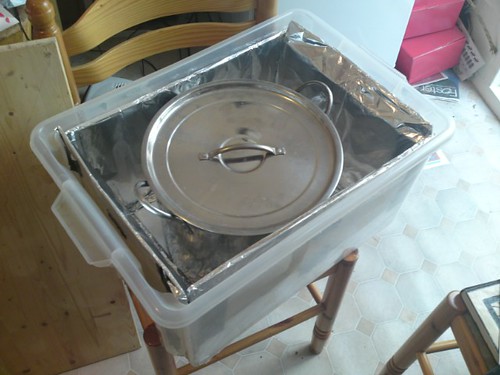While the idea of the haybox has been around for a long time, it seems that outside of crisis times people rarely use them. If you are posted somewhere with a fuel shortage or just want to save on the electricity or gas bill, setting up a haybox is cheap and can take as little time as it takes to gather a box and some insulation.
How it works:
A haybox works on the principle that you use retained heat to cook food as opposed to constantly replacing heat that is lost to into the air as in conventional cooking. Because everything is sealed in, much less heat can escape so you don’t need to keep a flame or other heat source going to constantly replace it.
What you need:
A box such as a thick cardboard or wooden one, or a chilly bin/Esky/ cooler. You can even dig into the ground as long as you can line it and close off the top effectively.
A pot with a tight-fitting lid. You do not want moisture escaping that will render your insulation ineffective.
Enough insulation to fill the space between the box and the pot which should be around 5-10cm thick (a couple of inches).
And, ideally, some aluminium foil to line the box with.
How to use it:
Depending on the item you are cooking, heat the food up to boiling and then simmer for a good 5-10 minutes or until heated through. For meat dishes this initial heating time should be longer and you may need to re-heat partway through your haybox cooking time. Once everything is sufficiently heated through, place it in the box and close the insulation and lid down tightly. Wait…, the longer the better so think ahead. If you check on the food and it’s not done, you will need to repeat the heating process from the beginning as opening the box will let out all the magic.
It takes two to four times as long as normal to cook something in a haybox. So, be sure to allow for the wait time.
What you can cook in it:
Anything you cook in a slowcooker (crockpot) can be done in a haybox but bear in mind that if your chunks, especially of meat, are big you may have to reheat the contents halfway through the cooking time so keep things small. Stews, curries and casseroles are the best and you can also do a mean pot of porridge (oatmeal). You can even do steamed puddings or breads.
Checkpoints:
-Be sure to use a cooking vessel that is the right size for the amount of food you are cooking. Having a large air pocket within the pot will reduce the effectiveness of the haybox.
-Choose insulating materials that will not melt or give off toxic fumes when in contact with the hot pot. Obviously you can use hay, but also any dry grass, woolen blankets, newspaper or shredded paper will do. You could also try down pillows, corn husks or other dry vegetable matter such as buckwheat hulls, but bear in mind that it will be difficult to get your hot pot into an ever-filling hole if you use something with tiny pieces. In a pinch you could use your down jacket or sleeping bag, but be wary of melting the material. Hot meal, good. Holey sleeping bag, not good.
-Hayboxes are better for cooking larger amounts of food since the mass will hold more heat.
-Keep health and safety in mind as you are cooking with a low heat. If you don’t bring your food all the way up to boiling before placing it in the haybox, you could be asking for trouble.


Leave a Reply